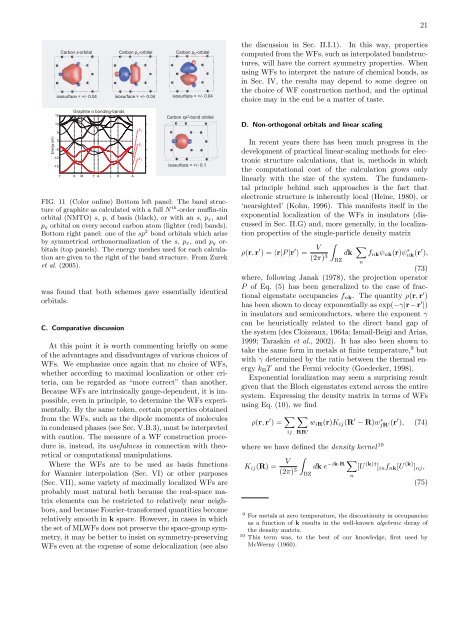Maximally localized Wannier functions: Theory and applications
Maximally localized Wannier functions: Theory and applications
Maximally localized Wannier functions: Theory and applications
Create successful ePaper yourself
Turn your PDF publications into a flip-book with our unique Google optimized e-Paper software.
21<br />
Energy (eV)<br />
-10<br />
-15<br />
Carbon s-orbital Carbon p x -orbital Carbon p y -orbital<br />
isosurface = +/- 0.04 isosurface = +/- 0.04 isosurface = +/- 0.04<br />
15<br />
10<br />
5<br />
0<br />
-5<br />
Γ<br />
Graphite σ bonding-b<strong>and</strong>s<br />
K<br />
M<br />
Γ A<br />
L<br />
H<br />
A<br />
E 2<br />
E 1<br />
E 0<br />
Carbon sp 2 -bond orbital<br />
isosurface = +/- 0.1<br />
FIG. 11 (Color online) Bottom left panel: The b<strong>and</strong> structure<br />
of graphite as calculated with a full N th -order muffin-tin<br />
orbital (NMTO) s, p, d basis (black), or with an s, p x, <strong>and</strong><br />
p y orbital on every second carbon atom (lighter (red) b<strong>and</strong>s).<br />
Bottom right panel: one of the sp 2 bond orbitals which arise<br />
by symmetrical orthonormalization of the s, p x, <strong>and</strong> p y orbitals<br />
(top panels). The energy meshes used for each calculation<br />
are given to the right of the b<strong>and</strong> structure. From Zurek<br />
et al. (2005).<br />
was found that both schemes gave essentially identical<br />
orbitals.<br />
C. Comparative discussion<br />
At this point it is worth commenting briefly on some<br />
of the advantages <strong>and</strong> disadvantages of various choices of<br />
WFs. We emphasize once again that no choice of WFs,<br />
whether according to maximal localization or other criteria,<br />
can be regarded as “more correct” than another.<br />
Because WFs are intrinsically gauge-dependent, it is impossible,<br />
even in principle, to determine the WFs experimentally.<br />
By the same token, certain properties obtained<br />
from the WFs, such as the dipole moments of molecules<br />
in condensed phases (see Sec. V.B.3), must be interpreted<br />
with caution. The measure of a WF construction procedure<br />
is, instead, its usefulness in connection with theoretical<br />
or computational manipulations.<br />
Where the WFs are to be used as basis <strong>functions</strong><br />
for <strong>Wannier</strong> interpolation (Sec. VI) or other purposes<br />
(Sec. VII), some variety of maximally <strong>localized</strong> WFs are<br />
probably most natural both because the real-space matrix<br />
elements can be restricted to relatively near neighbors,<br />
<strong>and</strong> because Fourier-transformed quantities become<br />
relatively smooth in k space. However, in cases in which<br />
the set of MLWFs does not preserve the space-group symmetry,<br />
it may be better to insist on symmetry-preserving<br />
WFs even at the expense of some delocalization (see also<br />
the discussion in Sec. II.I.1). In this way, properties<br />
computed from the WFs, such as interpolated b<strong>and</strong>structures,<br />
will have the correct symmetry properties. When<br />
using WFs to interpret the nature of chemical bonds, as<br />
in Sec. IV, the results may depend to some degree on<br />
the choice of WF construction method, <strong>and</strong> the optimal<br />
choice may in the end be a matter of taste.<br />
D. Non-orthogonal orbitals <strong>and</strong> linear scaling<br />
In recent years there has been much progress in the<br />
development of practical linear-scaling methods for electronic<br />
structure calculations, that is, methods in which<br />
the computational cost of the calculation grows only<br />
linearly with the size of the system. The fundamental<br />
principle behind such approaches is the fact that<br />
electronic structure is inherently local (Heine, 1980), or<br />
‘nearsighted’ (Kohn, 1996). This manifests itself in the<br />
exponential localization of the WFs in insulators (discussed<br />
in Sec. II.G) <strong>and</strong>, more generally, in the localization<br />
properties of the single-particle density matrix<br />
ρ(r, r ′ ) = ⟨r|P |r ′ ⟩ =<br />
V<br />
(2π)<br />
∫BZ<br />
3 dk ∑ f nk ψ nk (r)ψnk(r ∗ ′ ),<br />
n<br />
(73)<br />
where, following Janak (1978), the projection operator<br />
P of Eq. (5) has been generalized to the case of fractional<br />
eigenstate occupancies f nk . The quantity ρ(r, r ′ )<br />
has been shown to decay exponentially as exp(−γ|r−r ′ |)<br />
in insulators <strong>and</strong> semiconductors, where the exponent γ<br />
can be heuristically related to the direct b<strong>and</strong> gap of<br />
the system (des Cloizeaux, 1964a; Ismail-Beigi <strong>and</strong> Arias,<br />
1999; Taraskin et al., 2002). It has also been shown to<br />
take the same form in metals at finite temperature, 9 but<br />
with γ determined by the ratio between the thermal energy<br />
k B T <strong>and</strong> the Fermi velocity (Goedecker, 1998).<br />
Exponential localization may seem a surprising result<br />
given that the Bloch eigenstates extend across the entire<br />
system. Expressing the density matrix in terms of WFs<br />
using Eq. (10), we find<br />
ρ(r, r ′ ) = ∑ ∑<br />
w iR (r)K ij (R ′ − R)wjR ∗ ′(r′ ), (74)<br />
ij RR ′<br />
where we have defined the density kernel 10<br />
K ij (R) =<br />
V<br />
(2π) 3 ∫BZ<br />
dk e −ik·R ∑ n<br />
[U (k)† ] in f nk [U (k) ] nj ,<br />
(75)<br />
9 For metals at zero temperature, the discontinuity in occupancies<br />
as a function of k results in the well-known algebraic decay of<br />
the density matrix.<br />
10 This term was, to the best of our knowledge, first used by<br />
McWeeny (1960).













